A Journey into the Serene World of Japandi Interior Design
In a bustling world filled with the constant hum of activity and digital noise, there exists a growing yearning for sanctuary—a haven of tranquility where one can seek solace and connection. It is within the realms of interior design that this longing finds expression, weaving together the timeless philosophies of Wabi-Sabi and Hygge to create a harmonious sanctuary known as Japandi.
Rooted in the ancient Japanese concept of Wabi-Sabi, which celebrates the beauty of imperfection and impermanence, and the Danish notion of Hygge, which embraces coziness, warmth, and contentment, Japandi emerges as a captivating fusion of two distinct yet harmonious design philosophies. It embodies simplicity, authenticity, and a deep reverence for nature—offering a refuge from the chaos of modern life and inviting us to embrace the beauty in simplicity.
As we embark on this journey into the serene world of Japandi interior design, let us delve deeper and uncover the principles, colors, and textures that define Japandi, and discover how you can bring the serene beauty of this aesthetic into your own home.
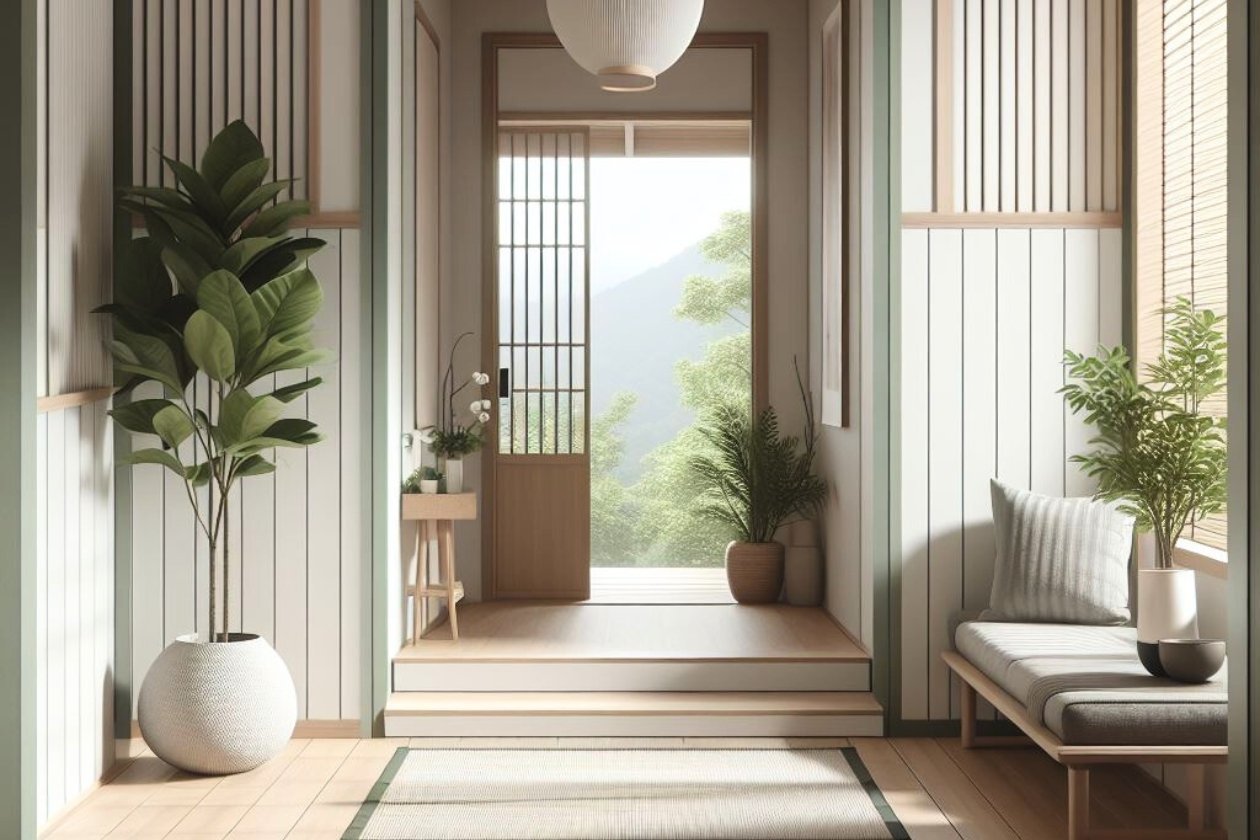
Unveiling the Tranquil Fusion: Exploring the Essence of Japandi Interior Design
In the ever-evolving landscape of interior design, where trends wax and wane with the passing seasons, a captivating fusion has emerged, seamlessly blending the timeless elegance of Japanese minimalism with the rustic charm of Scandinavian design. This harmonious amalgamation, affectionately termed "Japandi," embodies serenity, functionality, and understated beauty, captivating homeowners and designers alike with its tranquil allure.
Origins of Japandi:
The term "Japandi" is a portmanteau, a delightful marriage of "Japanese" and "Scandinavian," denoting the union of two distinct yet complementary design philosophies. While Japanese design emphasizes simplicity, harmony, and a deep respect for natural elements, Scandinavian design exudes warmth, functionality, and clean lines. It was only natural that these two aesthetics would eventually converge, giving birth to the captivating Japandi style.
Defining Characteristics:
At the heart of Japandi lies a reverence for simplicity and functionality. Clean lines, uncluttered spaces, and a focus on natural materials such as wood, stone, and bamboo form the cornerstone of this aesthetic. Neutral color palettes dominate, with shades of white, beige, grey, and muted earth tones creating a serene backdrop reminiscent of Nordic landscapes.
Furniture in Japandi interiors is characterized by its sleek, minimalist design, often featuring organic shapes and natural finishes. Pieces are selected for their functionality and craftsmanship, embodying the Japanese principle of "wabi-sabi," which celebrates imperfection and the beauty of the imperfect.
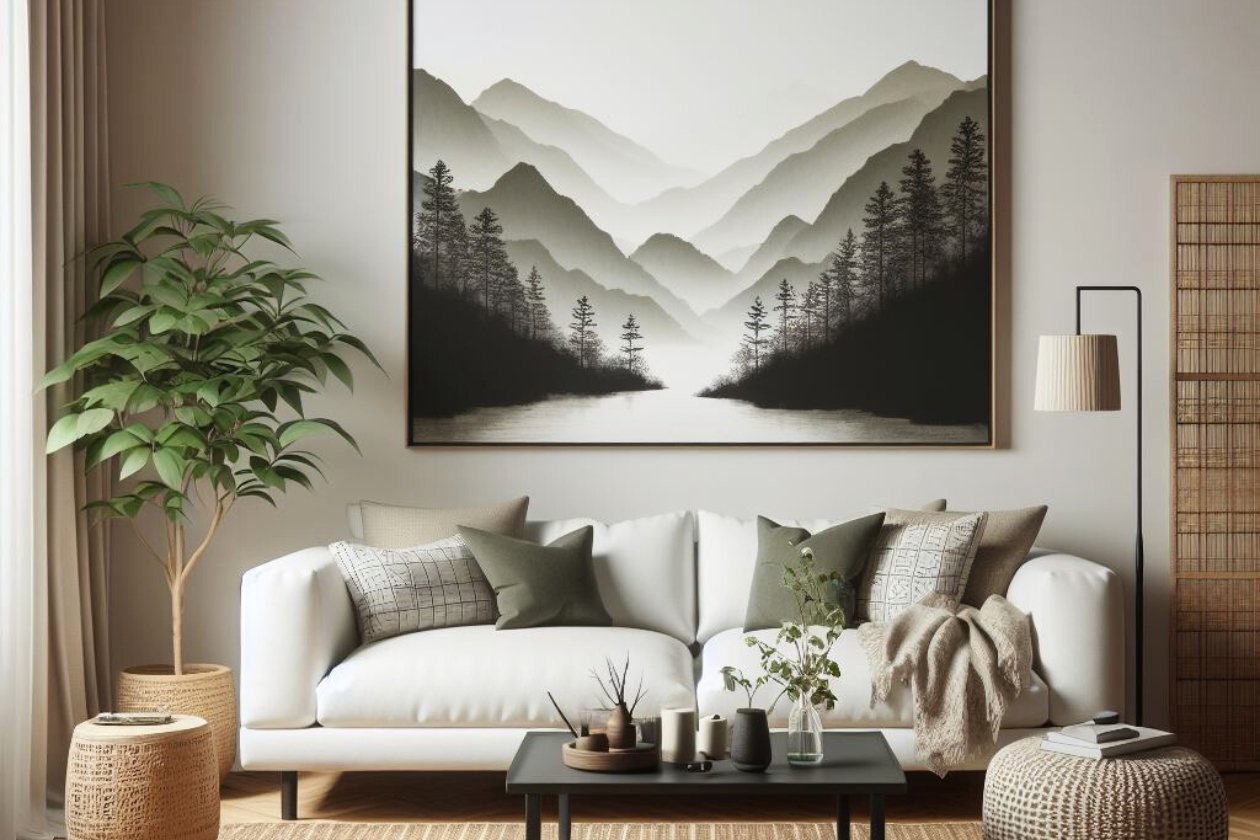
Popularity and Appeal:
The rise of Japandi interior design can be attributed to its universal appeal and its ability to create spaces that are both visually pleasing and conducive to well-being. In a fast-paced world inundated with stimuli, Japandi offers a retreat—a sanctuary of calm and simplicity where one can unwind and reconnect with the essence of living.
Furthermore, the versatility of Japandi makes it suitable for a wide range of architectural styles and living spaces, from cozy apartments to spacious homes. Its emphasis on functionality and comfort makes it particularly appealing to those seeking to create homes that are not only beautiful but also practical and livable.
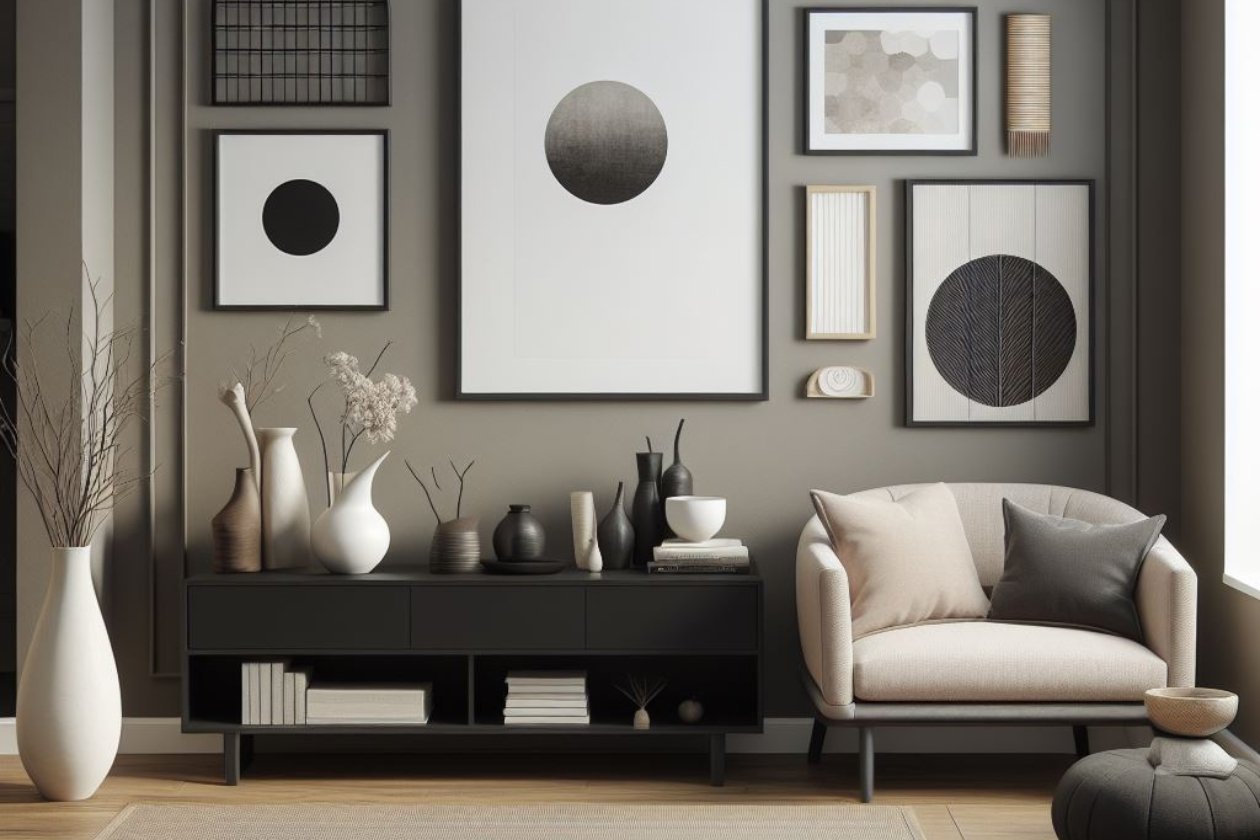
Colors of Japandi:
The color palette of Japandi interior design is a fundamental element that sets the tone for the entire space, evoking a sense of tranquility, warmth, and harmony. Here's a more detailed exploration of the colors commonly found in Japandi interiors:
- Neutrals: Neutrals form the foundation of Japandi color schemes, creating a serene backdrop that allows other elements to shine. Shades of white, cream, beige, and light grey dominate, imparting a sense of airiness and openness to the space. These neutral hues serve as a canvas upon which other colors and textures can be layered, contributing to the overall sense of calm and cohesion.
- Earthy Tones: In addition to neutrals, Japandi interiors often incorporate muted earthy tones to add warmth and depth to the space. Soft greens reminiscent of lush foliage, warm browns evocative of natural wood, and gentle blues reminiscent of serene skies are common choices. These earthy hues bring a sense of connection to nature indoors, fostering a feeling of peace and tranquility.
- Soft Pastels: While Japandi interiors typically favor a restrained color palette, soft pastel tones can also make an appearance, adding subtle hints of color without overpowering the space. Soft blush pinks, pale blues, and muted greens can infuse a sense of delicacy and warmth into the room, creating a gentle contrast against the neutral backdrop.
- Monochromatic Accents: To add visual interest and depth to Japandi interiors, monochromatic accents are often incorporated in shades slightly darker or lighter than the base neutrals. For example, deeper shades of grey or taupe can be used for textiles such as cushions, throws, or rugs, creating subtle contrast and visual texture. Similarly, lighter shades of white or beige can be used for decorative accents such as vases, ceramics, or artwork, adding dimension to the space.
- Natural Wood Tones: While not strictly a color, natural wood tones play a significant role in Japandi interiors, contributing warmth, texture, and visual interest. Light wood tones such as oak, birch, or maple are favored for their soft, organic appeal, while darker wood tones such as walnut or mahogany can add a sense of depth and richness to the space. Incorporating wooden furniture, flooring, or accents brings an element of nature indoors, enhancing the overall sense of harmony and balance.
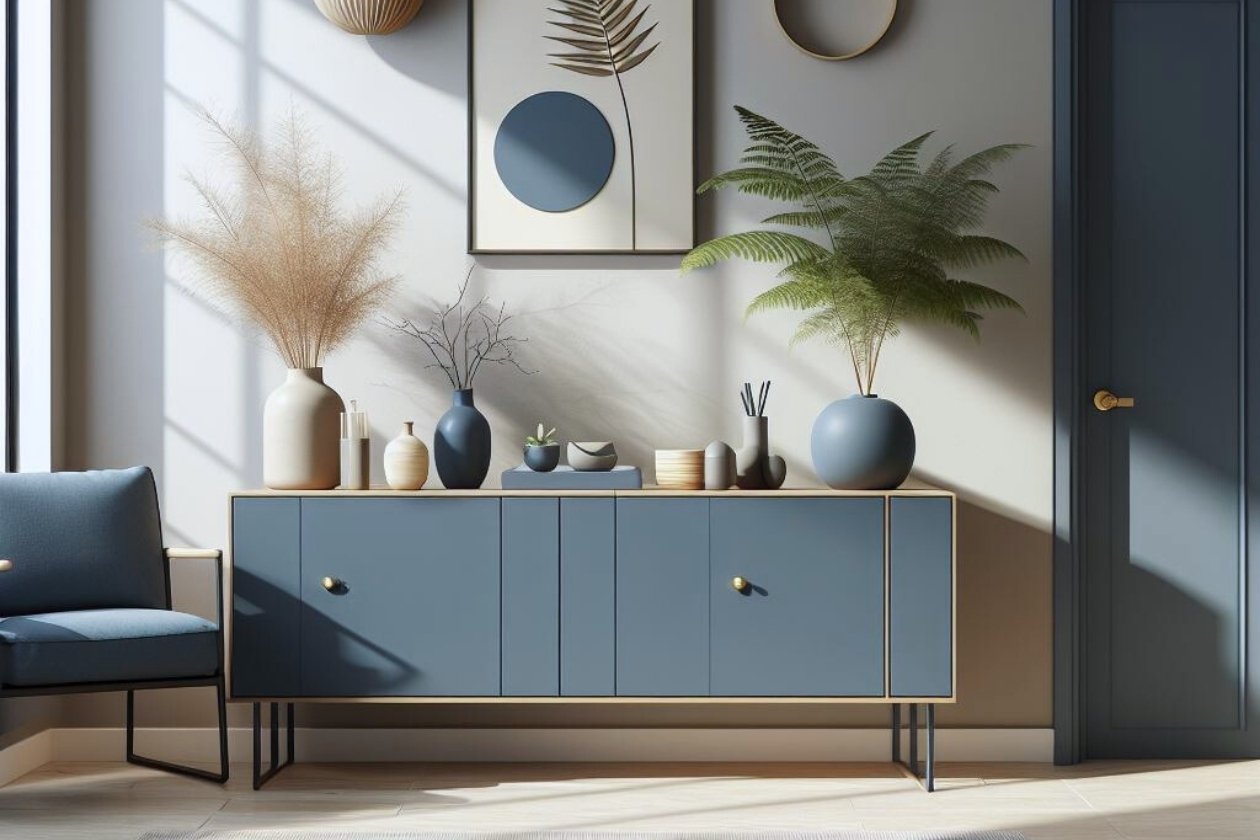
Meanwhile.. 👀 Looking for Japandi paint colors for your home?
Search no further. I have three sets of carefully hand-picked harmonious Sherwin Williams colors to alleviate the daunting task of selecting the perfect paint colors. Each 9-color collection is a result of meticulous selection, ensuring every hue harmoniously complements your interior and exterior spaces.
The stunning colors seamlessly transition from walls to cabinets and furniture, exuding timeless elegance. Due to its versatility, this color scheme also enhances various interior design aesthetics including Farmhouse, Bohemian, Scandinavian, Contemporary, Minimalist, Modern, Shabby Chic, Rustic, and French Country styles.
Japandi color palette option No.1.
Check it out on my store!
'Japandi Style' paint color palette
Presenting "Japandi Style," a meticulously curated color palette featuring nine captivating hues, including light to dark neutrals. This professionally crafted palette is tailored for individuals seeking to embody the essence of Japandi-style living.
Explore the versatility of three whites, perfect for trim or whole-house application. Delve into the palette with three neutrals, ranging from a light warm gray to a medium-dark gray-taupe, alongside two medium-toned greens and a gorgeous dark gray-brown.
More details on what's included in the PDF e-book can be found here.
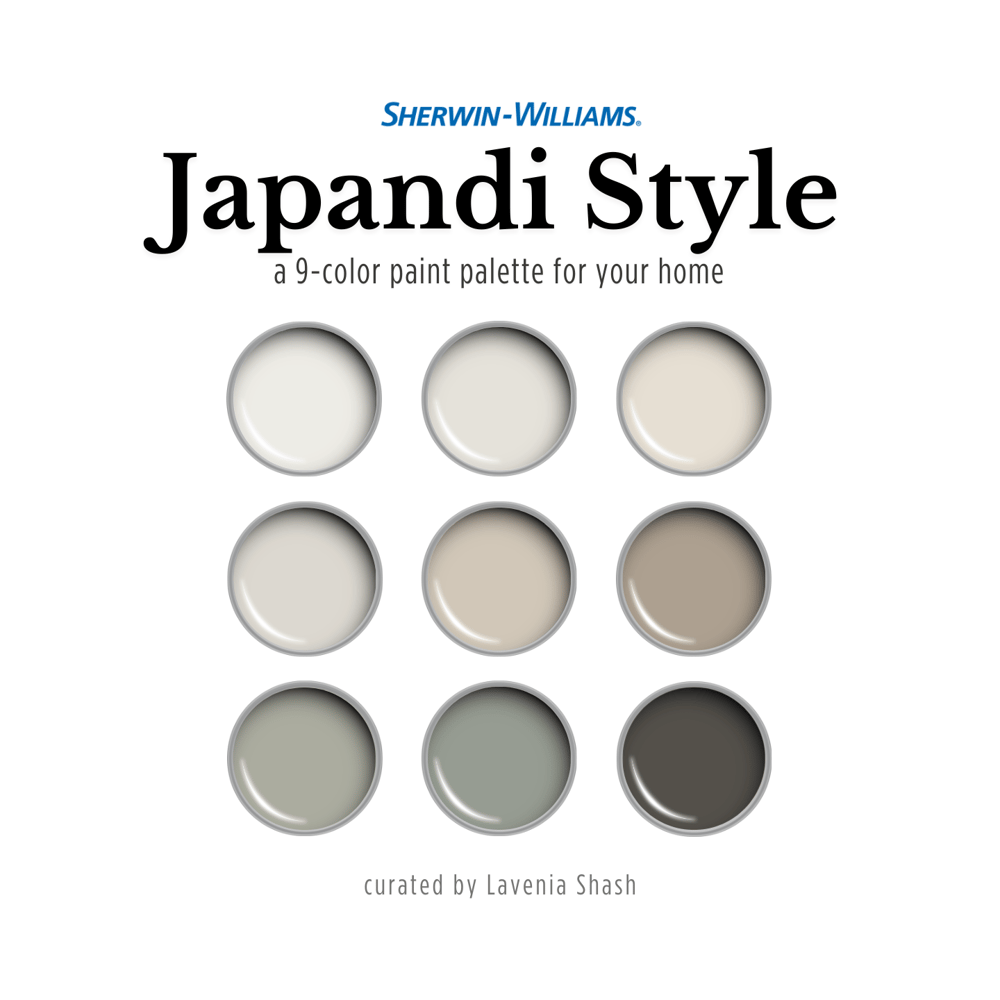
Japandi Style paint color palette
Japandi color palette option No.2.
Check it out on my store!
'Modern Japandi' paint color palette
Introducing "Modern Japandi," a meticulously curated color palette boasting nine captivating hues, from serene blues to versatile neutrals, designed for those embracing the essence of Japandi-style living with a modern twist.
Discover the versatility of two whites, ideal for both trim and whole-house applications. Dive into the palette with four neutrals, ranging from light warm gray to medium-dark warm-gray, complemented by two beautiful blues and a striking black.
More details on what's included in the PDF e-book can be found here.
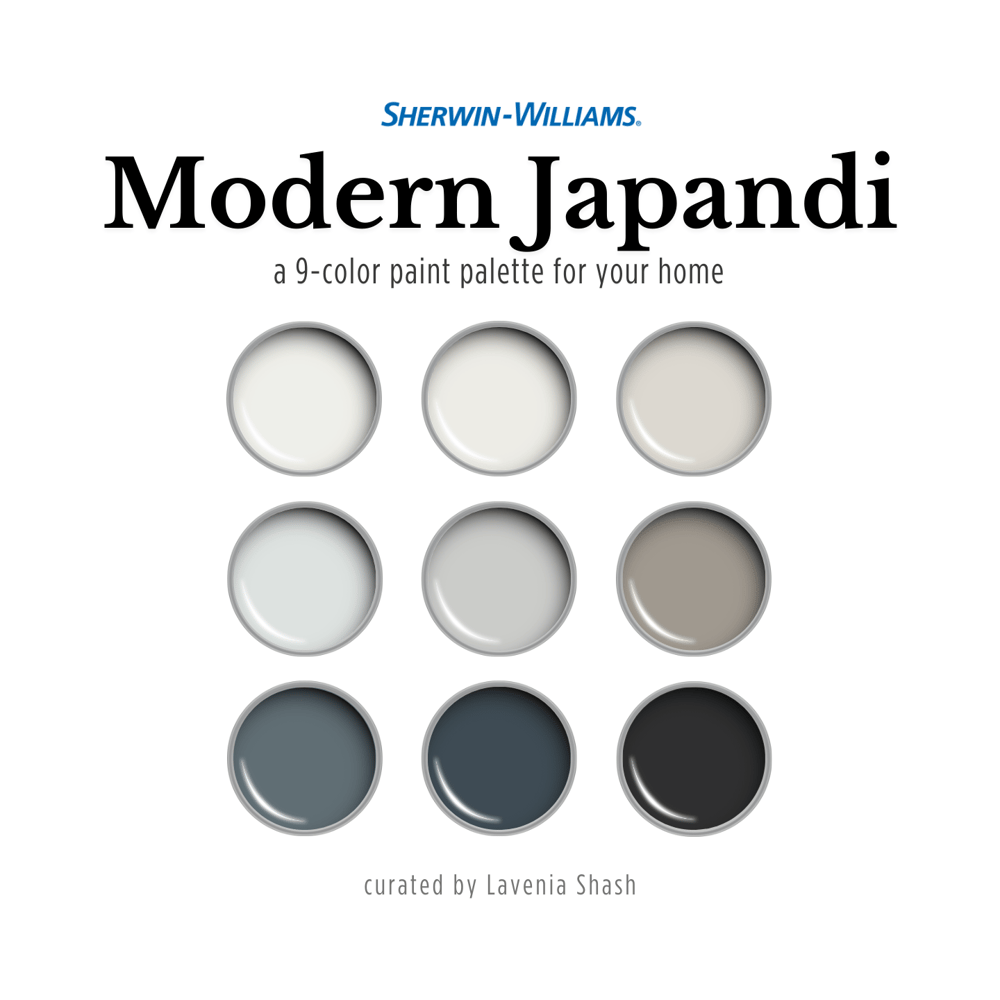
Modern Japandi paint color palette
Japandi color palette option No.3.
Check it out on my store!
'Japandi Organic' paint color palette
Introducing "Japandi Organic," a thoughtfully curated color palette featuring nine captivating hues, from serene whites to versatile neutrals, captivating greens, an earthy terracotta and a rich dark brown. This expertly crafted palette is tailored for those embracing the essence of Japandi-style living.
Discover the versatility of three whites, ideal for both trim and whole-house applications. Dive into the palette with two neutrals, spanning from a light tan to a medium-light greige, complemented by two medium to dark-toned greens and a striking dark brown. The palette also includes a stunning terracotta shade for added depth.
More details on what's included in the PDF e-book can be found here.
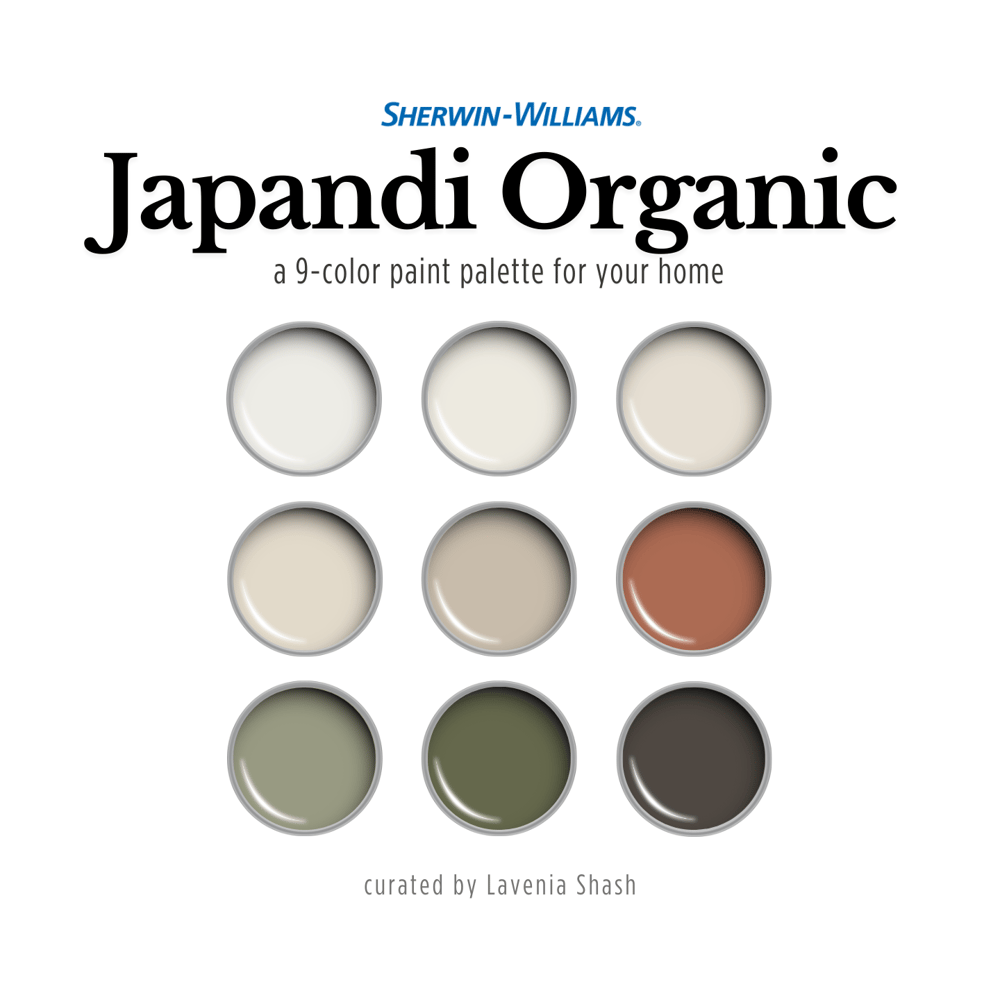
Japandi Organic paint color palette
Achieving the Japandi Aesthetic:
To bring the serene beauty of Japandi into your home, consider the following principles:
- Simplicity and Clean Lines: Embracing simplicity is at the core of Japandi design. Clean lines and uncluttered spaces define this aesthetic, allowing each element to breathe and harmonize with its surroundings. Opt for furniture and decor with minimalist profiles and streamlined silhouettes. Avoid overly ornate or fussy designs, opting instead for pieces that exude a sense of calm and tranquility. Keep surfaces clear of unnecessary clutter, focusing on essential items that contribute to the overall harmony of the space.
- Incorporating Natural Materials: Natural materials play a pivotal role in Japandi interiors, infusing warmth, texture, and a connection to nature into the space. Incorporate materials such as wood, stone, and bamboo to add organic beauty and authenticity to your home. Choose furniture and decor crafted from sustainable sources, celebrating the inherent beauty of natural materials while minimizing environmental impact. From wooden floors and furniture to stone countertops and woven textiles, prioritize the use of natural materials to create a sense of harmony and balance within your space.
- Embracing a Neutral Palette: A neutral color palette forms the foundation of Japandi design, fostering a sense of serenity, sophistication, and cohesion throughout the space. Choose colors such as white, beige, grey, and muted earth tones to create a calming backdrop that allows other elements to shine. Aim for a harmonious balance of light and dark tones, layering shades to create depth and visual interest. Introduce pops of color sparingly, focusing on soft accents that complement rather than overwhelm the overall aesthetic. By embracing a neutral palette, you can create a timeless and tranquil environment that exudes understated elegance and sophistication.
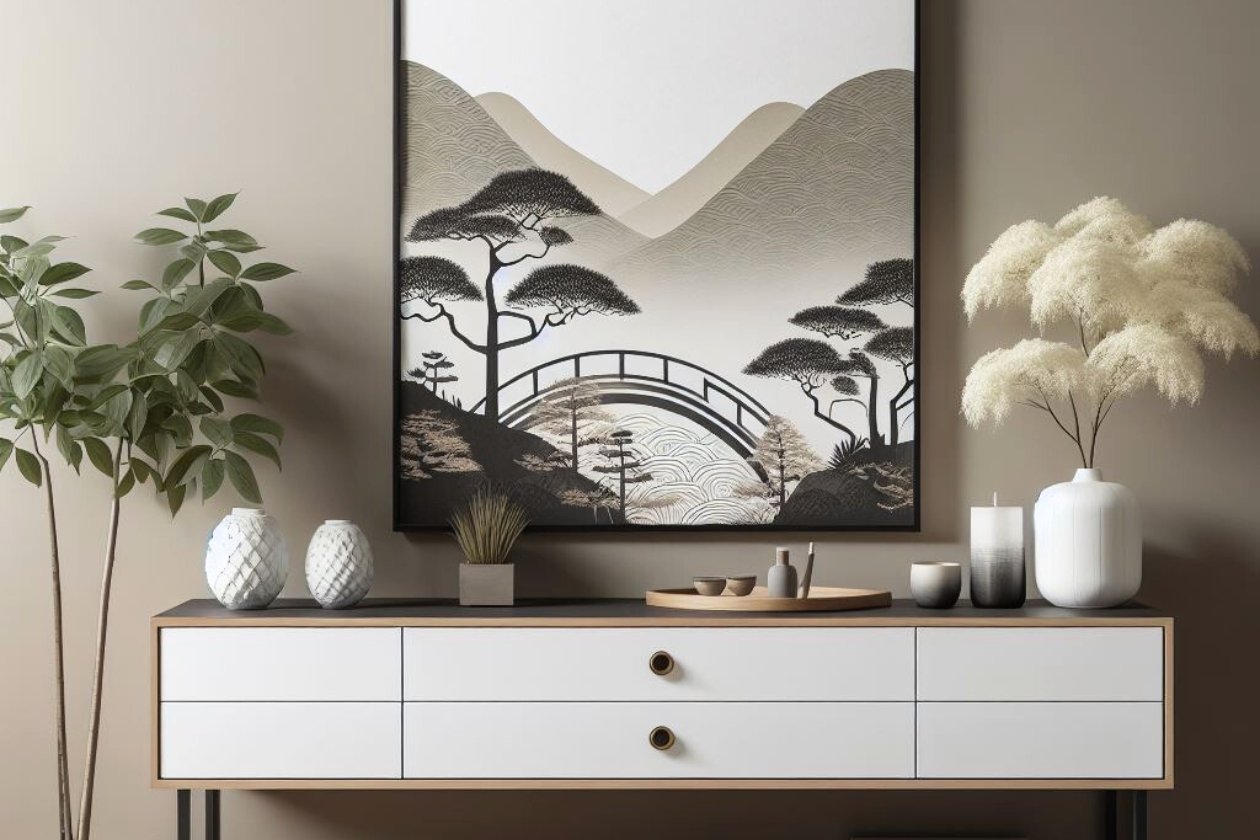
- Prioritizing Functional Design: Functional design is a hallmark of Japandi interiors, where form seamlessly integrates with function to create spaces that are both beautiful and practical. Select furniture and decor that prioritize functionality without sacrificing style. Look for pieces with simple yet elegant designs, focusing on quality craftsmanship and thoughtful details. Choose multifunctional furniture that serves multiple purposes, maximizing space and efficiency in your home. From storage solutions that blend seamlessly into the design to versatile pieces that adapt to your lifestyle, prioritize functionality in every aspect of your design choices.
- Striving for Balance and Harmony: Balance and harmony are key principles of Japandi design, where every element is carefully considered to create a cohesive and visually pleasing space. Strive for a balanced composition by arranging furniture and decor in a way that promotes flow and symmetry within the room. Pay attention to scale and proportion, ensuring that each piece harmonizes with its surroundings. Incorporate natural textures and materials to add depth and visual interest, creating a sense of balance between simplicity and complexity.
By carefully curating your design choices and embracing a sense of harmony, you can create a Japandi-inspired space that embodies tranquility, sophistication, and timeless elegance.
Happy decorating!
Lavenia
Disclaimer: The images presented here have been generated using artificial intelligence (AI) algorithms, with my original, unique prompts. They are artistic creations and often may not depict real-life scenes or objects. The use of AI technology in generating these images is intended for creative and inspirational purposes. Please be aware that these images are not based on actual photographs or physical objects. If you have any questions or would like more information about the AI-generated nature of these images, feel free to reach out.
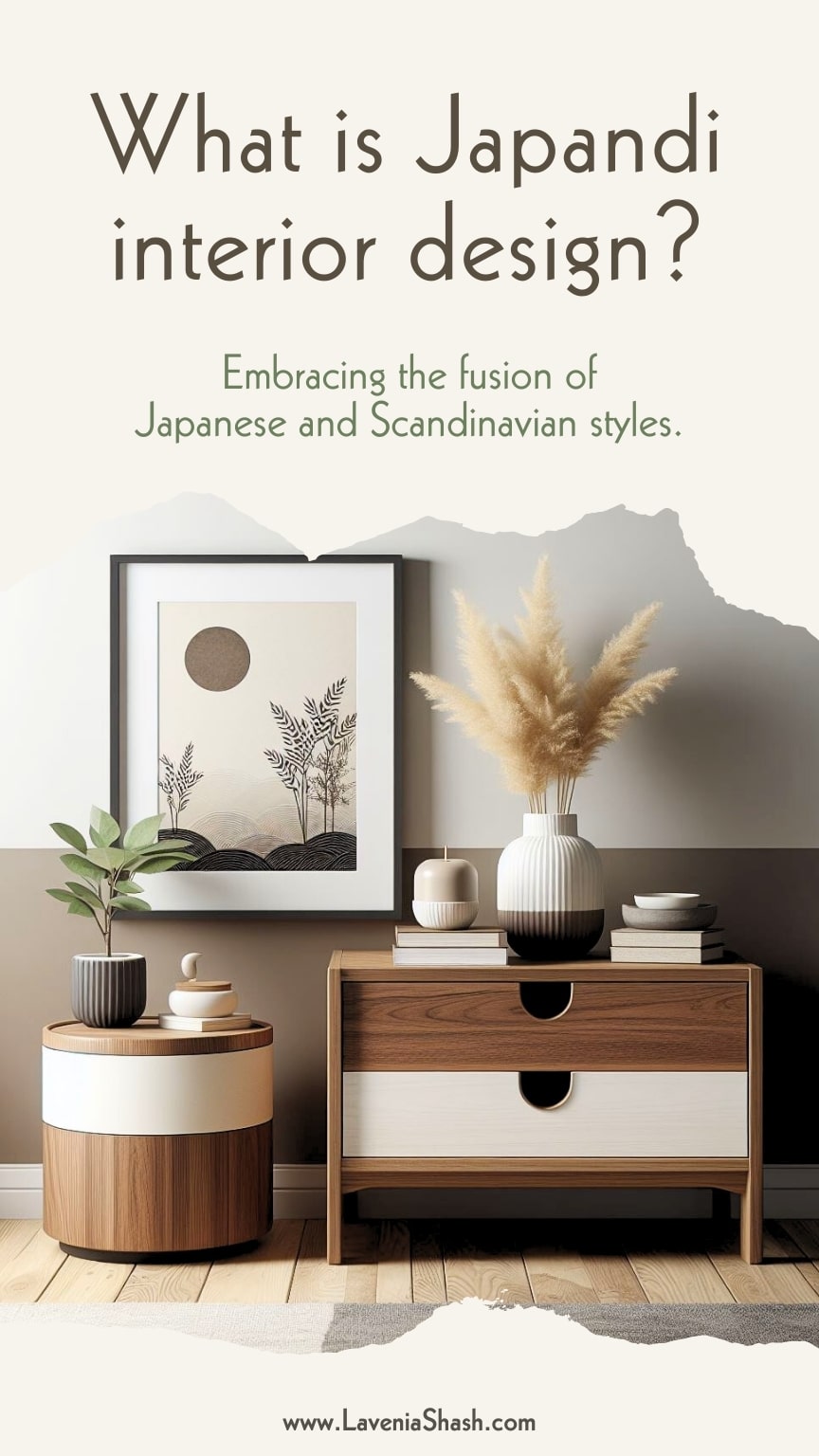
 Lavenia, an e-color consultant, has been pivotal in aiding numerous clients and homeowners in selecting the ideal paint for their living spaces. With over three decades of experience, she has refined her expertise as a skilled designer in both interior and graphic design, along with extensive involvement in the publishing sector. Moreover, she holds certification in social media marketing, broadening her professional capabilities.
Lavenia, an e-color consultant, has been pivotal in aiding numerous clients and homeowners in selecting the ideal paint for their living spaces. With over three decades of experience, she has refined her expertise as a skilled designer in both interior and graphic design, along with extensive involvement in the publishing sector. Moreover, she holds certification in social media marketing, broadening her professional capabilities.


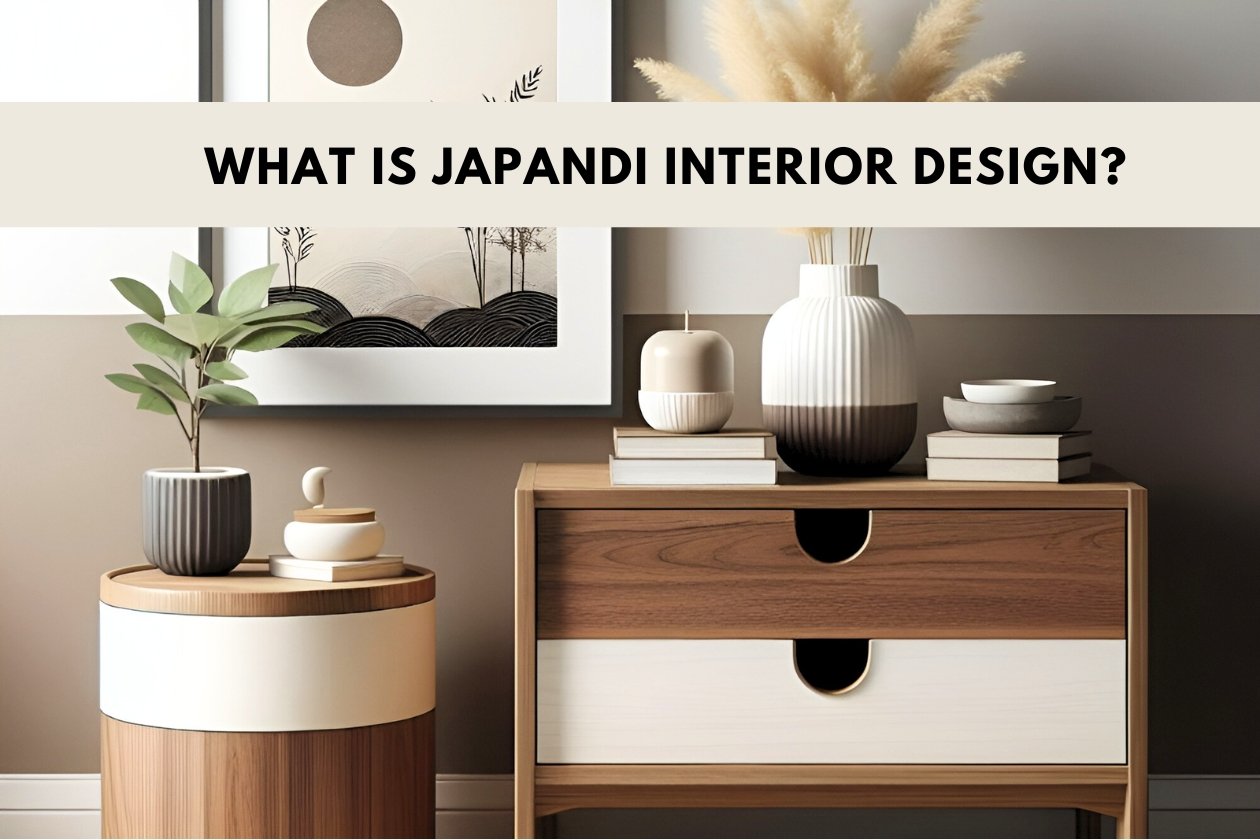
Comments ()